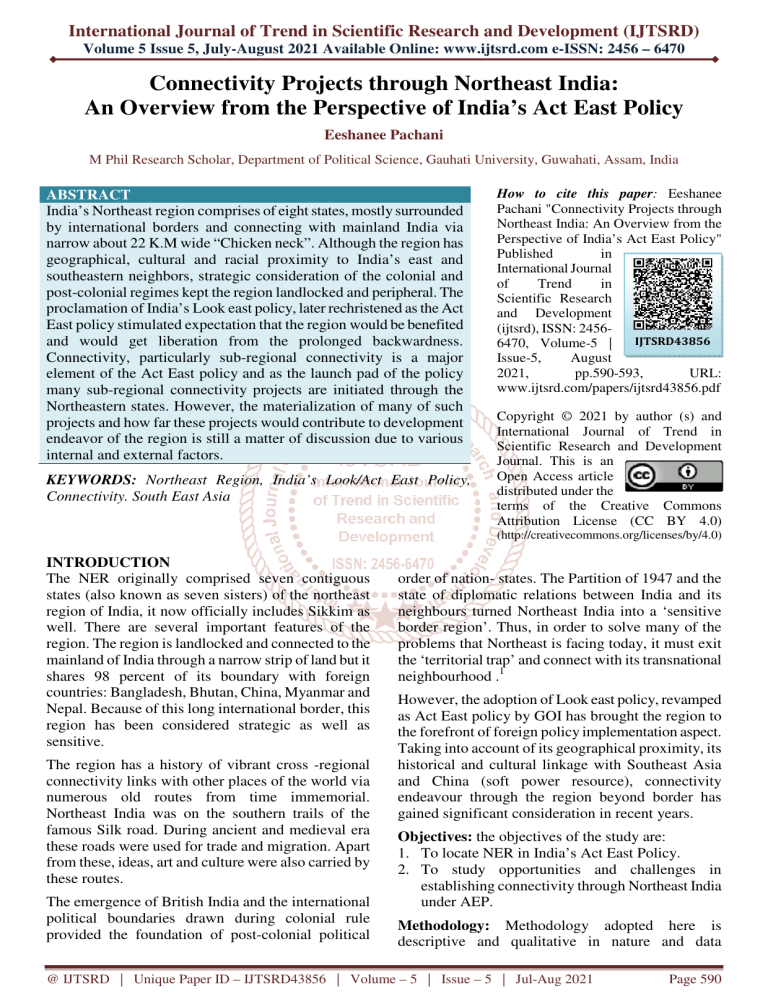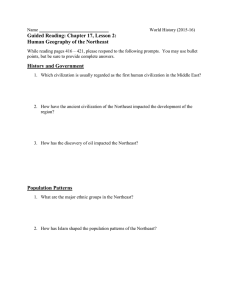77 Connectivity projects through Northeast India An overview from the perspective of India’s Act East policy
advertisement

International Journal of Trend in Scientific Research and Development (IJTSRD) Volume 5 Issue 5, July-August 2021 Available Online: www.ijtsrd.com e-ISSN: 2456 – 6470 Connectivity Projects through Northeast India: An Overview from the Perspective of India’s Act East Policy Eeshanee Pachani M Phil Research Scholar, Department of Political Science, Gauhati University, Guwahati, Assam, India ABSTRACT India’s Northeast region comprises of eight states, mostly surrounded by international borders and connecting with mainland India via narrow about 22 K.M wide “Chicken neck”. Although the region has geographical, cultural and racial proximity to India’s east and southeastern neighbors, strategic consideration of the colonial and post-colonial regimes kept the region landlocked and peripheral. The proclamation of India’s Look east policy, later rechristened as the Act East policy stimulated expectation that the region would be benefited and would get liberation from the prolonged backwardness. Connectivity, particularly sub-regional connectivity is a major element of the Act East policy and as the launch pad of the policy many sub-regional connectivity projects are initiated through the Northeastern states. However, the materialization of many of such projects and how far these projects would contribute to development endeavor of the region is still a matter of discussion due to various internal and external factors. KEYWORDS: Northeast Region, India’s Look/Act East Policy, Connectivity. South East Asia How to cite this paper: Eeshanee Pachani "Connectivity Projects through Northeast India: An Overview from the Perspective of India’s Act East Policy" Published in International Journal of Trend in Scientific Research and Development (ijtsrd), ISSN: 2456IJTSRD43856 6470, Volume-5 | Issue-5, August 2021, pp.590-593, URL: www.ijtsrd.com/papers/ijtsrd43856.pdf Copyright © 2021 by author (s) and International Journal of Trend in Scientific Research and Development Journal. This is an Open Access article distributed under the terms of the Creative Commons Attribution License (CC BY 4.0) (http://creativecommons.org/licenses/by/4.0) INTRODUCTION The NER originally comprised seven contiguous states (also known as seven sisters) of the northeast region of India, it now officially includes Sikkim as well. There are several important features of the region. The region is landlocked and connected to the mainland of India through a narrow strip of land but it shares 98 percent of its boundary with foreign countries: Bangladesh, Bhutan, China, Myanmar and Nepal. Because of this long international border, this region has been considered strategic as well as sensitive. The region has a history of vibrant cross -regional connectivity links with other places of the world via numerous old routes from time immemorial. Northeast India was on the southern trails of the famous Silk road. During ancient and medieval era these roads were used for trade and migration. Apart from these, ideas, art and culture were also carried by these routes. The emergence of British India and the international political boundaries drawn during colonial rule provided the foundation of post-colonial political order of nation- states. The Partition of 1947 and the state of diplomatic relations between India and its neighbours turned Northeast India into a ‘sensitive border region’. Thus, in order to solve many of the problems that Northeast is facing today, it must exit the ‘territorial trap’ and connect with its transnational neighbourhood .1 However, the adoption of Look east policy, revamped as Act East policy by GOI has brought the region to the forefront of foreign policy implementation aspect. Taking into account of its geographical proximity, its historical and cultural linkage with Southeast Asia and China (soft power resource), connectivity endeavour through the region beyond border has gained significant consideration in recent years. Objectives: the objectives of the study are: 1. To locate NER in India’s Act East Policy. 2. To study opportunities and challenges in establishing connectivity through Northeast India under AEP. Methodology: Methodology adopted here is descriptive and qualitative in nature and data @ IJTSRD | Unique Paper ID – IJTSRD43856 | Volume – 5 | Issue – 5 | Jul-Aug 2021 Page 590 International Journal of Trend in Scientific Research and Development @ www.ijtsrd.com eISSN: 2456-6470 collection is done from secondary sources like books, journal articles, research papers etc. Northeast region (NER) and Act East policy: The “Look East Policy” of India was initiated by the former Prime Minister Narasimha Rao (1991-1996) and has continued to enjoy energetic support from the successive administrations of Inder Kumar Gujral (1997-1998), Atal Bihari Vajpayee (1998-2004), Manmohan Singh (2004-2014) and Narendra Modi (2014- ), each of whom represents a different political party in India.2 Even though Look East Policy (LEP) had been part of India’s Foreign Policy since early 1990s,a North East perspective emerged at the official level only in October,2007 in a meeting of then Foreign Minister ,Shri Pranab Mukherjee and the CMs of the North Eastern States on the initiative of the Ministry of DONER.3 The policy has been evolving through many phases and under the Modi’s regime, in 2014, it has been renamed as the Act East Policy. This was formally announced in November 2014 when Modi unveiled the Act East policy at the 12th ASEAN-India Summit and EAS in Myanmar. Underlying India's renewed Act East/Look East policy are the "close linkages" between the country's foreign policy and "domestic developmental aspirations".4 This development-driven agenda has placed special emphasis on strengthening connectivity, including infrastructure, people-topeople contacts and trade. Geographical location of North east India is of crucial significance in India’s AEP (erstwhile LEP). The region is situated in the point where South Asia geographically integrates with SEA or vice versa.5 Thus, the NER is considered as the stepping stone to SEA. “... India is aware of the geo-economic potential of the North-Eastern region as a gateway to East and South-East Asia. I am convinced that by gradually integrating this region through cross-border market access, the North Eastern states can become the bridge between the Indian economy and what is beyond doubt the fastest growing and dynamic region of the world”-said by the then External Affairs Minister Pranab Mukherjee depicts the importance given to the region by the Centre to craft the AEP. India’s focus on sub-regional economic cooperation such as Bay of Bengal Multisectoral Technical and Economic Cooperation (BIMSTEC), Mekong Ganga Cooperation (MGC) and Bangladesh–China–India– Myanmar Regional Economic Forum (BCIM Forum) is with a view to reinforce the Look East policy and boost the development of the North-eastern region. The main aim of these groupings is to create an enabling environment for rapid economic development through identification and implementation of specific cooperation projects in trade and investment industry, technology, human resource development, tourism, agriculture, energy, infrastructure, technology, transport and communications, energy and fisheries.6 There have been numerous projects under LEP that are expected to tie India closer to East and Southeast Asia via Northeast India. The infrastructure projects that are in various stages of completion include Moreh-Tamu-Kalewa Road, India-Myanmar Thailand Trilateral Highway, Trans-Asian Highway, IndiaMyanmar rail linkages, Kaladan Multimodal project, Myanmar-India, Bangladesh gas and/or oil pipeline, Tamanthi Hydroelectricity project and optical fibre network between Northeast India and Southeast Asia.7 Moreover, there has been discussion on reopening the old routes of the region like World War II-era Stilwell Road that would link Assam with China’s Yunnan province via Myanmar. However, it is yet to be initiate for security consideration and for some other issues. Opportunities and challenges: Act East Policy is expected to usher in the new era of development for the North East through the network of pipelines, connectivity, communication and trade. The aspiration of overcoming the landlock status and ensure progress of the region through physical connectivity is ridden by both opportunities and challenges. However, with regard to the opportunities it may be argued that there can be several constructive outcomes apart from breaking the territorial trap for the northeast region and for India as a whole, if the Act East Policy which can be interpreted as a twenty-first century strategy for the development of the Northeastern region is pursued and transnational links and cooperation with India’s eastern neighbours are materialised. It would lead to laudable achievements for the Northeast as well as help in achieving goals of peace, security and cooperation with countries sharing India’s borders which underlies India’s overall policy towards it(s) neighborhood.8 Those connectivity links could be the facilitator of trade conducted over land across the region. Economists have argued that the lack of investment problem can be overcome if the markets of South, SEA and China are integrated with the region. In this attempt connectivity would play a crucial role. The tourism prospect is also expected to flourish through this emerging connectivity infrastructure. The NER is famous for its mesmerizing natural beauty. The region has immense potential for eco-tourism, @ IJTSRD | Unique Paper ID – IJTSRD43856 | Volume – 5 | Issue – 5 | Jul-Aug 2021 Page 591 International Journal of Trend in Scientific Research and Development @ www.ijtsrd.com eISSN: 2456-6470 heritage tourism, religious tourism, festival tourism etc. Therefore, connecting the region with SEA and other neighbours could attract tourists from within and outside the country. A streamlined connectivity promotes accessibility of healthcare facilities across the border. Trans-national connectivity projects via NER would be beneficial for the enhancement of health care sector in the region as well as in the context of medical tourism. Another significant development expected from linking the region with neighbouring nations is regrowth of cultural and ethnic bond across borders. The drawing of the border had spilt the ethnic contiguity of some communities residing at the bordering area. For instance, ethnic communities like the Konyak Naga tribe in the Nagaland-Burma border region, Kukis in Manipur, and Chin and Reang tribes in Mizoram sector have been separated and consequently they ended up being minorities in both countries. This leads to the problem of insurgency backed by the sense of ethnic insecurity and lost identity. There are several impediments to the realisation of the projects associated with the Look East Policy underway in Northeast India, which need to be overcome for the transnational projects in the Northeast and Southeast Asia to benefit the Northeast region. The construction of continental route projects that would pass through Northeast to link India with eastern and south eastern neighbours across mountainous terrain are considered hostile and cost ineffective. Such geographical feature of the region is a risk factor in the way of implementation of connectivity endeavours. Security sensitivity, both from external and internal factors, looms large regarding the Northeastern States. Maintenance of the routes requires not only money and technology, but also adequate security. The existence of various insurgencies and demands for statehood among several groups all along Northeast India, especially in the border areas, renders the region through which the lifelines of the LEP are being envisioned, extremely volatile, unpredictable and unattractive for potential investors.9 It is also argued that such connective links would promote greater cooperation among insurgents across borders. China factor has also contributed towards India’s hesitation to adopt some projects like reopening of historic Stilwell Road. Another point of security anxiety is that such connectivity corridors would facilitate movement of illegal migrants, drugs and other illegal stuffs, arms as well as infectious diseases. Besides, the socio-political unrest of neighbouring nations, which are pivotal to these connectivity projects also creates hindrances. To be summed up, conflicting economic interests, unresolved ethnic conflicts, poverty, rampant corruption, vested interests and recession in the state economies continue to act as deterrents to the successful execution of connectivity projects. Apart from these factors, India’s attitude towards its neighbours, be it China, Nepal, Bangladesh or Myanmar, are also important determinants for expanding regional cooperation with the states of Northeast India.10 Conclusion: India has been pushing for a greater regional integration with south, eastern and south east Asian nations through the AEP founded upon three main pillars commerce, culture and connectivity. Amongst these, connectivity has become vital in affirming the plausibility of reinforcing regional ties. In this effort, Northeast should not be the gateway for the implementation of AEP, rather be the point of convergence where trade facilitation would be possible. Sincere attempts should be made by the Government, both in state as well as central level to ensure full integration of the NER in growth process anticipating from the AEP and its connectivity endeavours. Not only in political arena, but the concern of civil society as well as practitioners is also indispensable to reap the benefits of potentialities of the region under the AEP. References: [1] Baruah, S. "Beyond Durable Disorder." Baruah, Sanjib. Durable Disorder: Understanding the Politics of Northeast India. New Delhi: Oxford University Press., 2005. 214. [2] Mir, J A. "India's Look East Policy: Its Evolution, Objective and Approach." International Journal for Social Studies, Volume 3 (2017). [3] F.No.17/8/2009-DONER (LEP)Govt.Of India, Ministry of Development of North Eastern Region. [4] Bajpaee C. “Dephasing India's Look East/Act East Policy”, Contemporary Southeast Asia, Vol. 39, No. 2 ISEAS - Yusof Ishak Institute (2017) pp. 348-372 [5] Das S, “Between South and Southeast Asia: Recasting India’s Northeast in the Age of Globalization,” Society Politics and @ IJTSRD | Unique Paper ID – IJTSRD43856 | Volume – 5 | Issue – 5 | Jul-Aug 2021 Page 592 International Journal of Trend in Scientific Research and Development @ www.ijtsrd.com eISSN: 2456-6470 Development in North East India, New Delhi, Concept Publishing Company (2008). [6] Haokip T. “India's Look East Policy: Its Evolution and Approach”, South Asian Survey 2011. [7] Shrivastava, S. “North East India and India’s Look East Policy”. The World Reporter, June (2013). [8] Patgiri R and Borah Hazarika O. “Locating Northeast in India’s Neighbourhood Policy.” India Quarterly, Vol. 72, No. pp. 235-249. Sage Publications, Ltd (2016). [9] Bhaumik S. “Look East through Northeast: Challenges and prospects for India”, ORF Occasional Paper No. 51., Observer Research Foundation. New Delhi (2014). [10] Srikanth H. “Look East Policy, Sub-regional Connectivity Projects and Northeast India.” Mainstreaming the Northeast in India’s Look and Act East Policy, Palgrave MacMillan (2017) pp.213-231. @ IJTSRD | Unique Paper ID – IJTSRD43856 | Volume – 5 | Issue – 5 | Jul-Aug 2021 Page 593



